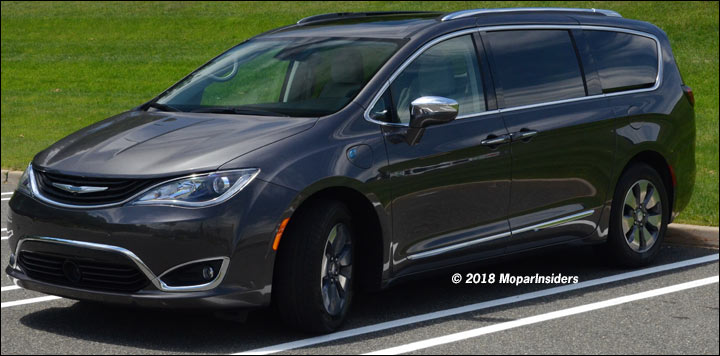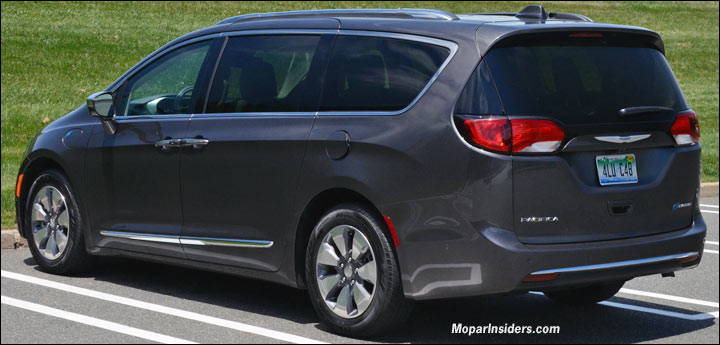Behind The Wheel: 2018 Chrysler Pacifica Hybrid:
ACarPlace.com Takes A Look At Chrysler's High Mileage Family Hauler...

2018 Chrysler Pacifica Hybrid. (David Zatz)
Our good friend automotive journalist and long time Mopar enthusiast David Zatz (ACarPlace.com), has spent some time behind the wheel of the 2018 Chrysler Pacifica Hybrid. Here is what he has to say about Chrysler’s high mileage family hauler…
Over the last week, I have been driving an energy-efficient car that seats six people comfortably, or two people with a stack of 4-by-8 wallboards. It defies popular impressions of hybrid cars by sprinting to highway speeds quickly, and always being ready for action; and by having surprisingly good handling. This miracle of modern engineering is the Chrysler Pacifica Hybrid, rated at a stunningly good 32 mpg (combined city/highway) if you never plug it in — and 84 mpg(e) if you do.
Chrysler worked on advanced hybrids in secret for years, and their very first in-house effort (discounting the old Durango/Aspen Hybrid) was a plug-in, with over 30 miles of pure-electric driving possible before it becomes a normal gas-electric hybrid. This is its story, in short — the very long version is running as a series over on acarplace.com.
First, because it is a hybrid, Chrysler followed Toyota in converting the Pentastar V6 to the Atkinson cycle, which is more efficient but can be less responsive — no matter, because a big electric motor (there’s also a little one) is there to push you forward with instant torque, no matter how many revs the gasoline engine is making, right down to zero revs. The combination powertrain holds 260 horsepower and 266 pound-feet of torque, but, again, responses are instantaneous. You can even drive purely on electric, beating other cars from the light up to highway speed, without the gasoline engine kicking in at all. Regenerative brakes put some electricity back into the battery while you’re coasting or braking.
You can save good deal of cash whether you use gasoline or not, since the cost of driving 25 miles is $1.30 on pure electric and $2.28 on gasoline — compared to a standard Pacifica’s $3.32. If you drive for 15,000 miles per year, 55% in the city, the EPA claims you’ll save around $6,000 in five years. More, if you spend time waiting for people with the a/c blasting; the Pacifica can do that on battery, with the engine off.
The motors are fairly loud, possibly on purpose, to remind you that you’re in a plug-in hybrid. On the highway, when you can’t hear the engine most of the time, you can tell what’s going on via a display in the 8.4” stereo screen.
The continuously variable transmission, which includes the motors, is programmed to seem like a conventional automatic, except when you slow to a stop or move at a crawl; then you might hear some crackling noises from the powertrain, and it might shake a little. Otherwise, the system seems perfectly tuned.

2018 Chrysler Pacifica Hybrid. (David Zatz)
Handling, Braking, and General Driving:
The low center of gravity (batteries below the seats) makes the Hybrid feel even better around hairpin turns than the normal Pacifica, and both are a real improvement over past Dodges, Plymouths, and Chryslers. The big van felt confident, even over bumpy concrete surfaces, but the added weight also brought bumps into the cabin and made the effects of speed bumps worse. The ride is still comfortable, but it’s not as plush as the non-hybrid version. Wind noise and the droning of other cars is mainly killed off by active noise cancellation, a nice trick; tire drone can still get in, especially over concrete, but the Pacifica is still quite quiet.
The 360° camera view is a real plus for parking, especially in tight places, and you can look at an overhead view or a front camera in addition to the usual rear view; you can also use the self-parking, a neat gimmick that does park the car perfectly, though probably not quite the way you would do it. It does parallel and perpendicular parking, and it does it very well, though the parallel parking takes a little more space than you might have.
As with the regular Pacifica, the Hybrid is quite large inside, and you can reach that space easily. It’s far more useful for carrying gear than a Durango or Explorer, thanks to the flat-folding seats and utilitarian styling. The middle seats in the Hybrid are removable, rather than stowing; it’s easy enough to do. The rear seats do fold in, quite easily. All the seats are contoured and supportive, and there’s easily room for six full-size adults (including room to get to their seats).
The gauge cluster was redone for the hybrid mission, with the left gauge replaced by a physical charge/discharge meter; the speedometer, always digital, is either at the top of the center display, or in huge digits in the middle. The 7-inch customizable center trip computer/gauge is standard on the Hybrid, and includes Trip A and B, navigation, and such.

2018 Chrysler Pacifica Hybrid. (David Zatz)
Controls have big buttons so you can wear gloves and drive. The new center stack is nicer to look at and more convenient than the traditional vertical center stacks. There’s lots of storage in the stack, too, with a huge bin that slides out (and another for the middle row). UConnect is, well, UConnect, the best of its kind. The interior, in cream-and-black with electric blue stitching, is very attractive and upscale-feeling.
The Pacifica has an optional seatback display, with two ten-inch screens on the backs of the front seats (nothing for the rearmost row); they can be driven by an optical disc up front, or they can be driven separate USB or HDMI inputs, or they can let kids play games, including a very simple one that updates how far you are from the destination every 15 minutes or so.

2018 Chrysler Pacifica Hybrid. (David Zatz)
Pricing It Out:
The base Pacifica Hybrid Touring Plus costs $41,340 plus destination, and it comes quite well equipped, including power side doors and a good deal of safety gear. There’s a leather-and-such version for $2,000 more, and the Hybrid Limited comes in $3,000 above that — $46,340 including destination. That’s not too much for a minivan these days, and it includes hands-free power sliding doors (just kick your foot under it and it opens) and liftgate, and Nappa leather seats — a softer, nicer leather.
Our car had the Advanced SafetyTec Group, a bargain at $995, for the 360° cameras, advanced brake assist, cruise control that can stop the car, automatic high beams, forward collision warning, lane departure warning with variable levels of intervention, auto-parking, front and rear parking beepers (the rear one will even stop the van before you hit), and rain-sensitive wipers. We also had the $1,595 panoramic sunroof, which is nice but much harder to justify; the front part slides open, and it has a power slider for the front and a manual slider for teh third-row section. We also had “KeySense,” a $175 option which lets you program each key/fob with stereo, seat, and mirror preferences, and a top speed restriction, with adjustable warning and intervention thresholds, for parents to give to teens — or to use themselves when they’re afraid of getting a ticket or a crash.
Even equipped as ours was, the Pacifica Hybrid was priced well against normal Honda and Toyota minivans. It lets you get away with fuel-economy murder; it costs a bit more up front, but if you have cheap power (perhaps your own solar or wind), or if gas prices rise, or if you have a rough commute that drops ordinary gas mileage to well below EPA estimates, you can probably save a lot of money. In the meantime, you can enjoy the cool factor — and I’m including “staying cool,” running the air conditioner on battery while you wait for someone to get out of school, with the engine off.
Chrysler has leapfrogged the minivan field yet again; now it’s time to get the word out. Most people are stunned to discover that Chrysler makes a plug-in hybrid minivan, or that it gets economy-car gas mileage. Perhaps more people should know about it, especially since there aren’t many drawbacks.
https://moparinsiders.com/behind-the-wheel-2018-chrysler-pacifica-hybrid/
ACarPlace.com Takes A Look At Chrysler's High Mileage Family Hauler...

2018 Chrysler Pacifica Hybrid. (David Zatz)
Our good friend automotive journalist and long time Mopar enthusiast David Zatz (ACarPlace.com), has spent some time behind the wheel of the 2018 Chrysler Pacifica Hybrid. Here is what he has to say about Chrysler’s high mileage family hauler…
Over the last week, I have been driving an energy-efficient car that seats six people comfortably, or two people with a stack of 4-by-8 wallboards. It defies popular impressions of hybrid cars by sprinting to highway speeds quickly, and always being ready for action; and by having surprisingly good handling. This miracle of modern engineering is the Chrysler Pacifica Hybrid, rated at a stunningly good 32 mpg (combined city/highway) if you never plug it in — and 84 mpg(e) if you do.
Chrysler worked on advanced hybrids in secret for years, and their very first in-house effort (discounting the old Durango/Aspen Hybrid) was a plug-in, with over 30 miles of pure-electric driving possible before it becomes a normal gas-electric hybrid. This is its story, in short — the very long version is running as a series over on acarplace.com.
First, because it is a hybrid, Chrysler followed Toyota in converting the Pentastar V6 to the Atkinson cycle, which is more efficient but can be less responsive — no matter, because a big electric motor (there’s also a little one) is there to push you forward with instant torque, no matter how many revs the gasoline engine is making, right down to zero revs. The combination powertrain holds 260 horsepower and 266 pound-feet of torque, but, again, responses are instantaneous. You can even drive purely on electric, beating other cars from the light up to highway speed, without the gasoline engine kicking in at all. Regenerative brakes put some electricity back into the battery while you’re coasting or braking.
You can save good deal of cash whether you use gasoline or not, since the cost of driving 25 miles is $1.30 on pure electric and $2.28 on gasoline — compared to a standard Pacifica’s $3.32. If you drive for 15,000 miles per year, 55% in the city, the EPA claims you’ll save around $6,000 in five years. More, if you spend time waiting for people with the a/c blasting; the Pacifica can do that on battery, with the engine off.
The motors are fairly loud, possibly on purpose, to remind you that you’re in a plug-in hybrid. On the highway, when you can’t hear the engine most of the time, you can tell what’s going on via a display in the 8.4” stereo screen.
The continuously variable transmission, which includes the motors, is programmed to seem like a conventional automatic, except when you slow to a stop or move at a crawl; then you might hear some crackling noises from the powertrain, and it might shake a little. Otherwise, the system seems perfectly tuned.

2018 Chrysler Pacifica Hybrid. (David Zatz)
Handling, Braking, and General Driving:
The low center of gravity (batteries below the seats) makes the Hybrid feel even better around hairpin turns than the normal Pacifica, and both are a real improvement over past Dodges, Plymouths, and Chryslers. The big van felt confident, even over bumpy concrete surfaces, but the added weight also brought bumps into the cabin and made the effects of speed bumps worse. The ride is still comfortable, but it’s not as plush as the non-hybrid version. Wind noise and the droning of other cars is mainly killed off by active noise cancellation, a nice trick; tire drone can still get in, especially over concrete, but the Pacifica is still quite quiet.
The 360° camera view is a real plus for parking, especially in tight places, and you can look at an overhead view or a front camera in addition to the usual rear view; you can also use the self-parking, a neat gimmick that does park the car perfectly, though probably not quite the way you would do it. It does parallel and perpendicular parking, and it does it very well, though the parallel parking takes a little more space than you might have.
As with the regular Pacifica, the Hybrid is quite large inside, and you can reach that space easily. It’s far more useful for carrying gear than a Durango or Explorer, thanks to the flat-folding seats and utilitarian styling. The middle seats in the Hybrid are removable, rather than stowing; it’s easy enough to do. The rear seats do fold in, quite easily. All the seats are contoured and supportive, and there’s easily room for six full-size adults (including room to get to their seats).
The gauge cluster was redone for the hybrid mission, with the left gauge replaced by a physical charge/discharge meter; the speedometer, always digital, is either at the top of the center display, or in huge digits in the middle. The 7-inch customizable center trip computer/gauge is standard on the Hybrid, and includes Trip A and B, navigation, and such.

2018 Chrysler Pacifica Hybrid. (David Zatz)
Controls have big buttons so you can wear gloves and drive. The new center stack is nicer to look at and more convenient than the traditional vertical center stacks. There’s lots of storage in the stack, too, with a huge bin that slides out (and another for the middle row). UConnect is, well, UConnect, the best of its kind. The interior, in cream-and-black with electric blue stitching, is very attractive and upscale-feeling.
The Pacifica has an optional seatback display, with two ten-inch screens on the backs of the front seats (nothing for the rearmost row); they can be driven by an optical disc up front, or they can be driven separate USB or HDMI inputs, or they can let kids play games, including a very simple one that updates how far you are from the destination every 15 minutes or so.

2018 Chrysler Pacifica Hybrid. (David Zatz)
Pricing It Out:
The base Pacifica Hybrid Touring Plus costs $41,340 plus destination, and it comes quite well equipped, including power side doors and a good deal of safety gear. There’s a leather-and-such version for $2,000 more, and the Hybrid Limited comes in $3,000 above that — $46,340 including destination. That’s not too much for a minivan these days, and it includes hands-free power sliding doors (just kick your foot under it and it opens) and liftgate, and Nappa leather seats — a softer, nicer leather.
Our car had the Advanced SafetyTec Group, a bargain at $995, for the 360° cameras, advanced brake assist, cruise control that can stop the car, automatic high beams, forward collision warning, lane departure warning with variable levels of intervention, auto-parking, front and rear parking beepers (the rear one will even stop the van before you hit), and rain-sensitive wipers. We also had the $1,595 panoramic sunroof, which is nice but much harder to justify; the front part slides open, and it has a power slider for the front and a manual slider for teh third-row section. We also had “KeySense,” a $175 option which lets you program each key/fob with stereo, seat, and mirror preferences, and a top speed restriction, with adjustable warning and intervention thresholds, for parents to give to teens — or to use themselves when they’re afraid of getting a ticket or a crash.
Even equipped as ours was, the Pacifica Hybrid was priced well against normal Honda and Toyota minivans. It lets you get away with fuel-economy murder; it costs a bit more up front, but if you have cheap power (perhaps your own solar or wind), or if gas prices rise, or if you have a rough commute that drops ordinary gas mileage to well below EPA estimates, you can probably save a lot of money. In the meantime, you can enjoy the cool factor — and I’m including “staying cool,” running the air conditioner on battery while you wait for someone to get out of school, with the engine off.
Chrysler has leapfrogged the minivan field yet again; now it’s time to get the word out. Most people are stunned to discover that Chrysler makes a plug-in hybrid minivan, or that it gets economy-car gas mileage. Perhaps more people should know about it, especially since there aren’t many drawbacks.
https://moparinsiders.com/behind-the-wheel-2018-chrysler-pacifica-hybrid/
